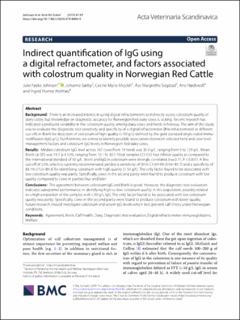| dc.contributor.author | Johnsen, Julie Føske | |
| dc.contributor.author | Johanne, Sørby | |
| dc.contributor.author | Mejdell, Cecilie Marie | |
| dc.contributor.author | Sogstad, Åse Margrethe | |
| dc.contributor.author | Nødtvedt, Ane C. W. | |
| dc.contributor.author | Holmøy, Ingrid Hunter | |
| dc.date.accessioned | 2020-10-16T13:40:14Z | |
| dc.date.available | 2020-10-16T13:40:14Z | |
| dc.date.created | 2019-11-27T13:21:39Z | |
| dc.date.issued | 2019 | |
| dc.identifier.issn | 1751-0147 | |
| dc.identifier.uri | https://hdl.handle.net/11250/2683412 | |
| dc.description.abstract | Background: There is an increased interest in using digital refractometers to indirectly assess colostrum quality of dairy cattle, but knowledge on diagnostic accuracy for Norwegian Red dairy cows is lacking. Recent research has indicated a profound variability in the colostrum quality among dairy cows and herds in Norway. The aim of this study was to evaluate the diagnostic test sensitivity and specificity of a digital refractometer (Brix refractometer) at different cut-offs in Brix% for detection of colostrum of high quality (> 50 g/L) defined by the gold standard single radial immunodiffusion (IgG g/L). Furthermore, we aimed to identify possible associations between selected herd and cow-level management factors and colostrum IgG-levels in Norwegian Red dairy cows. Results: Median colostrum IgG level across 167 cows from 19 herds was 35.0 g/L, ranging from 5 to 129 g/L. Mean Brix% (± SD) was 19.7 ± 4.12%, ranging from 10.1 to 30.5. Most samples (72.5%) had inferior quality as compared to the international standard of 50 g/L. Brix% and IgG in colostrum were strongly correlated (r = 0.71, P < 0.001). A Brix cut-off of 22%, which is currently recommended, yielded a sensitivity of (95% CI) 69.4% (54.6–81.7) and a specificity of 83.1% (75.0–89.3) for identifying colostrum with high quality (> 50 g/L). The only factor found to be associated with low colostrum quality was parity. Specifically, cows in the second parity were found to produce colostrum with low quality compared to cows in parities four and later. Conclusions: The agreement between colostrum IgG and Brix% is good. However, the diagnostic test evaluation indicates suboptimal performance in identifying high vs. low colostrum quality in this population, possibly related to a high proportion of the samples with < 50 g/L IgG. The only factor found to be associated with low colostrum quality was parity. Specifically, cows in the second parity were found to produce colostrum with lower quality. Future research should investigate colostrum and serum IgG levels which best prevent calf illness under Norwegian conditions. | en_US |
| dc.language.iso | eng | en_US |
| dc.rights | Navngivelse 4.0 Internasjonal | * |
| dc.rights.uri | http://creativecommons.org/licenses/by/4.0/deed.no | * |
| dc.title | Indirect quantification of IgG using a digital refractometer, and factors associated with colostrum quality in Norwegian Red Cattle | en_US |
| dc.type | Peer reviewed | en_US |
| dc.type | Journal article | en_US |
| dc.description.version | publishedVersion | en_US |
| dc.source.volume | 61 | en_US |
| dc.source.journal | Acta Veterinaria Scandinavica | en_US |
| dc.source.issue | 1 | en_US |
| dc.identifier.doi | 10.1186/s13028-019-0494-9 | |
| dc.identifier.cristin | 1753075 | |
| dc.relation.project | Norges forskningsråd: 268023 | en_US |
| cristin.unitcode | 192,16,3,0 | |
| cristin.unitname | Institutt for produksjonsdyrmedisin | |
| cristin.ispublished | true | |
| cristin.fulltext | original | |
| cristin.qualitycode | 1 | |

